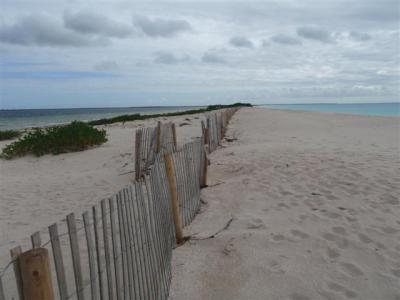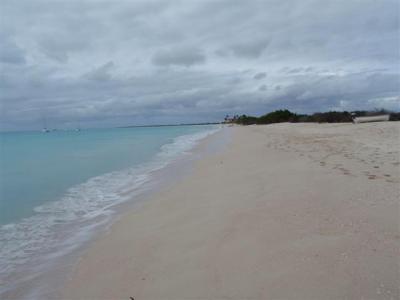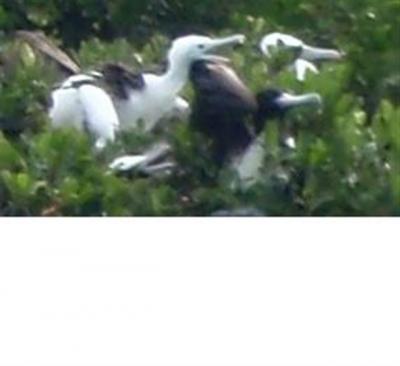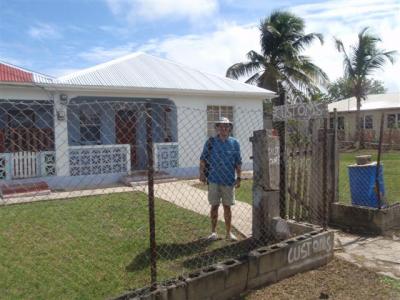Just in case anyone is unclear, yesterday’s post was an April Fool’s joke. There is no magical algae, at least that we know of. The duty free fuel in Guadeloupe is dyed green, which was why we had to go to the special pumps. When we saw the green fuel, we knew it would be the ideal joke.
So, back to our travel log: Last night we found out there is one drawback to this anchorage. The resort uses a very loud generator that they run all night. It must drive the hotel guests mad.
This morning we were up early, preparing to go to the one and only town of Codrington to check into the country. From where we are, there are two choices to get to the village. You can either drag your dinghy across the sandbar and into the lagoon, then take yourself over to the village, located due east on the other side of the lagoon. Or you can take your dinghy to the sand bar and beach it, then call a water taxi to pick you up from the sandbar and take you across the lagoon.
Yesterday we had scoped out the length of the sandbar. The shrubbery looked to be too thick to drag a dinghy through along most of the bar. Where the shrubbery was thin, a fence had been put up. Clearly, they were trying to stop cruisers from dragging their dinghies across. So, we were going to call the water taxi to come and get us.
As we were getting ready, we heard Arielle call the water taxi on the radio and arrange for a tour of the bird sanctuary in the north end of the lagoon. The public is forbidden from going into the sanctuary without a guide, so we couldn’t have taken our own dinghy there even if we wanted to. We quickly called in and invited ourselves along. Then a boat in a different anchorage called on the radio and asked if anyone wanted to go to the bird sanctuary with them. They had not heard our conversation with the water taxi. We invited them along and made arrangements for the taxi to pick them up on their way to getting us.
We headed over to the narrowest part of the sand bar to await the taxi. Yesterday it had been flat calm, but today there were small, but sharp and consistent waves hitting the shore. We pulled onto the sandbar with no problems. The sand is so gloriously soft here. It is the softest sand we have ever felt. It also has a slight pink hue to it from all the tiny pink shells in it. The first shot is facing south. The ocean bay is to the right, the protected lagoon to the left. The second shot is facing north. You can see the boats anchored in the background, and to the right you can see the shrubbery thickens up and can barely make out the hotel.


We chatted with the three crew from Arielle until the taxi arrived. The ride over to the sanctuary was wet. As in dripping wet from head to toe by the time we arrived. The sanctuary is filled with low growing mangroves and houses all kind of birds, including tropical mockingbirds, warblers, pelicans, ibis, oyster catchers, herons and numerous species of ducks. Right now it is frigate mating season and this sanctuary is their nesting ground. While we may see other birds around, the sole purpose of the trip was to watch the frigate’s mating rituals.
The farther into the reserve we got, the thicker and denser the mangroves became. We were beginning to think it would be a let down because we hadn’t seen any birds at all. Then we turned a corner and stopped. The particular spot in front of us and to the sides of us were covered in birds. Some were flying in the air, but most were perched in the bushes.

The male frigates have a red pouch on the front of their necks, called a gula pouch. Most of the time it is shriveled up and barely noticeable. During mating season, the males blow their pouch up. The pouch gets disproportionately large and looks like a big red balloon tied around their little necks. The red pouches look so odd on the birds that when we first pulled up, Christi mistook the numerous red orbs for fruit on the bushes.

The males sit in a bush and try to look sexy. The females circle above the bushes and check out all the candidates. They choose a partner, then descend on him and they mate. After mating, the male gathers twigs and builds a small nest. The female only lays one egg, and it is about twice the size of a chicken egg. The males and females take turns sitting on the egg while the other hunts for food. Once the chick has hatched, for three months both the males and females hunt for food to bring back to the chick. After the three months, the male leaves. The females and the chick stay behind. The mother continues to feed the chick for another 8 months before it goes off on its own. Frigates have the longest parental care period of any bird.
The male birds will go to another breeding ground, sometimes go as far away as the Galapagos or the Yucatan. What ever breeding ground they wind up in, they repeat the mating ritual all over again, then return to the sanctuary in Barbuda in time for the next mating season. Meanwhile, the females live in the same sanctuary year round. She does not breed again until after the chick has left the nest.
Frigates only weigh two to three pounds and have lightest body weight to wing span ratio of all birds. They can literally fly all day without rest, and will often go to other islands looking for food to bring back. Frigates have weak legs and can’t fly out of the water if submerged. Since they can’t dive for fish, they feed on fish that live close to the surface, such as flying fish. They are also notorious for stealing other birds catches, hence their nicknames “Man o War” and “Pirate Birds”. They live about 35 years.
We watched the birds for a long time as our guide related all the above information and more that we have since forgotten. We were fascinated by the adorable chicks. They are not too much smaller than a full grown frigate, all white and fuzzy, and incredibly cute.

The juveniles have white heads with a black body. The adult makes are all black, and the adult females have a white chest. National Geographic did an article on them a few years ago. The reporters set up camp in the heart of where a huge flock of frigates lived. As soon as the humans entered their territory, all the frigates moved to a different area of the reserve. Years later, the frigates have never gone back to that one area. We suppose it is safe to say the frigates are definitely sensitive to human interference in their wetlands.
As we were leaving the sanctuary, the couple on the boat farther away proposed that we all going sightseeing together. We took them up on it, but Arielle didn’t. We dropped Arielle’s crew off at the sand bar and the water taxi took us into town. The other couple said they didn’t mind waiting for us while we checked in. They wandered off to explore the town. The boat taxi driver led Christi and Eric to a taxi min-van. He got behind the wheel and told us he would take us to the various officials. We thought this was unnecessary, since the town is tiny and we could have walked it with no problem.
However, it turned out we absolutely needed his help in finding the officials. The first official we were supposed to see was Port Authority. The driver called her on her cell phone and asked her where she was and said he was coming to get her. He picked her up and took us all back to her house, which she works out of. She was dressed in a cheerful sundress and was very nice. Jerry Springer was on in the living room as she gave us our cruising permit, which cost $10 USD. What she must think of Americans after watching that show!
The next stop was customs, and here again the agent works out of his house. The Port Authority agent had no sign in front of her house, but this house had a couple home made signs clearly marking it as “Customs”. The agent didn’t answer the door when we knocked. The taxi driver said he must be home because his bike was there. He banged loudly and yelled for the agent to answer. A neighbor came out and said the agent had gone around the corner, and the neighbor went and fetched him for us. The agent quickly came to the house. He was casually dressed in athletic wear, and while professional, was quite curt. There was only one form to fill out and no fees.

The third stop was immigration. She actually works out of a commercial office, and the office was closed for lunch. The taxi driver hunted down the rest of the party and took us to a restaurant around the corner for lunch at the island’s self-proclaimed best restaurant. Today’s choices were goat stew or chicken wings, and we got one of each. The meals were served with salad, rice and beans, and a small wedge of sweet potato or yam. The food was OK, not spectacular. Very simple, down home cooking. But it was kind of exciting to be eating real local cuisine that has not been dressed up at all for us tourists.
To be continued tomorrow”¦

That customs sure beats Fiji… remember the fun checking in and out???